Since Friday was the last market day of the year, let's look at how the numbers we have been following came out for the year.
The price of gold rose 18.9% from $437.10 to $519.70 in 2005 in dollar terms and 36.1% in euros, having begun the year at 322.32 and closing at 438.60 euros an ounce. Oil rose 40.5% from $43.45 dollars a barrel at the beginning of 2005 to $61.04 at year's end. In euros, oil rose 60.2% from 32.09 euros a barrel at the beginning of the year to 51.43 on December 30th. The price of oil outpaced the price of gold for the year, with the gold/oil ratio going from 10.06 at the beginning of the year to 8.51 last week, a fall of 18.2% for the year. The U.S. dollar began the year at 0.7390 euros and closed the year at 0.8440, a gain of 14.2%. The euro fell from 1.3532 to 1.1849 dollars for the year. The U.S. stock market treaded water in 2005, with the Dow ending slightly down for the year and the NASDAQ slightly up. The Dow started the year at 10,783 and closed at 10,717.50 for a drop of 0.6% for the year. The NASDAQ went from 2175 to 2205 for the year, rising 1.4%. In U.S. interest rates, the yield on the ten-year U.S. Treasury note went from 4.22% to 4.39% for the year, a rise of 17 basis points.
Here are the charts for the year:
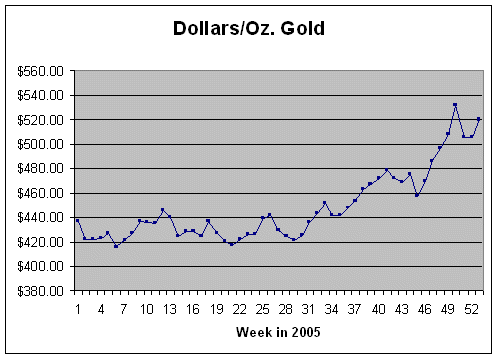
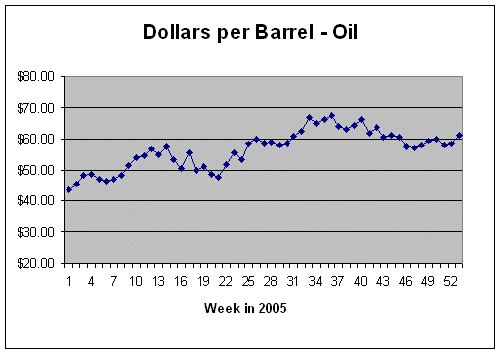
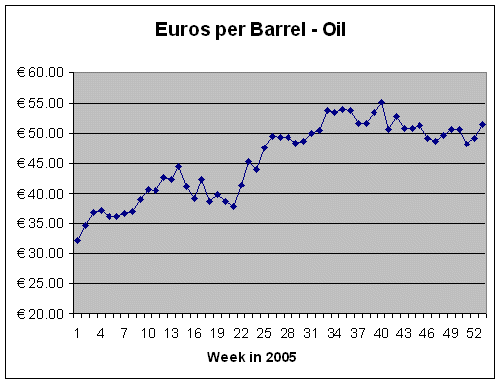
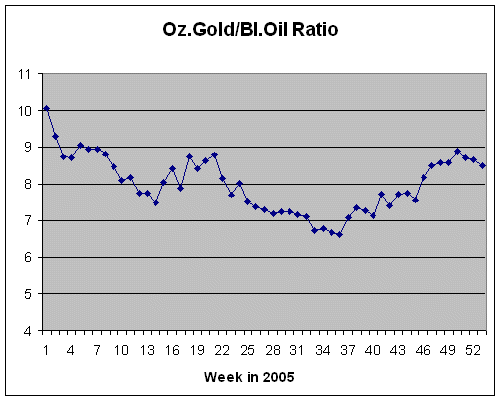
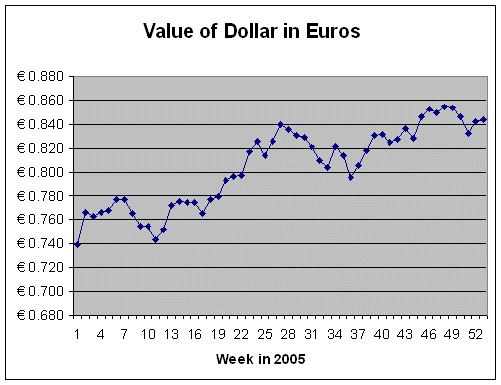
In some ways the situation is similar to what we saw at the beginning of 2005: A world economy still functioning, yet in danger of collapse due to serious structural imbalances. The world economy has not yet collapsed, but the imbalances are worse than they were a year ago. The housing bubble in the United States, the sole reason U.S. consumers have felt wealthy enough to spend, is popping. The trade imbalances are worsening, and the prospects for the U.S. empire do not look good. Even the normally optimistic U.S. public now senses that something is seriously wrong. Clear, unmistakable evidence of climate change, media-stoked fears of deadly epidemics, and a loss of confidence in the conduct of the Iraq War, and the belated realization that the United States is ruled by a criminal gang, all these things will undoubtedly weigh on the confidence of the U.S. consumer in 2006. And the U.S. consumer has been, after all, keeping the world economy afloat.
If you read the mainstream media's year-end economic wrap-ups, you might think that those of us who warned of economic collapse a year ago have cried wolf and that there is therefore no longer a reason to worry about the economy. Leaving aside the probability of an HEE, a Huge Exogemous Event, to use George Ure's term, all the reasons we had to fear collapse are still here and may even be stronger. Here's Morgan Stanley's chief analyst, Stephen Roach:
Global: The Symbiosis TrapMainstream analysts are also predicting a "soft landing" for the housing market.
Stephen Roach
MorganStanley.com
A year ago, the macro debate was dominated by concerns over mounting global imbalances. Our 2005 outlook piece, modestly entitled "How to Fix the World," probed in great detail the coming rebalancing of a lopsided world economy. The passage of time has not treated this outcome kindly. Global imbalances have continued to mount, but few seem to care these days. I suspect that 2006 will be a year when that ambivalence is shattered.
The broad consensus of financial market participants has come to the conclusion that there is a new symbiosis between America's record-setting external deficit and those willing to fund it. China is typically singled out as the most willing participant in the "symbiosis trade" - the arrangement whereby the US buys goods made in China in exchange for China's willingness to buy bonds printed in Washington. On the surface, this seems like a terrific deal for both - providing American consumers with the interest rate subsidy needed to sustain wealth- and debt-dependent spending and helping China limit an appreciation in its currency that might otherwise hamper its export prowess. Because this implicit contract has enabled China to keep its currency tightly aligned with the US dollar, many have also referred to the new symbiosis as a "Bretton Woods II" regime - the modern-day sequel to the dollar-based international financial architecture that was adopted in the aftermath of World War II. Advocates of this view conclude that since it is in both parties' best interests to perpetuate the symbiosis, there is no reason why it should change. With net foreign purchases of long-term US securities averaging $114 billion in September and October 2005, the latest facts are certainly not getting in the way of that logic.
I worry, however, that the sustainability of the symbiosis trade is predicated on a very dangerous ex post rationalization of global imbalances. As was the case in the midst of recent bubbles in equities, bonds, credit, and property, there are important kernels of truth to the notion of a new international symbiosis. The increased trade and capital flows that stem from the cross-border connectivity of globalization create a growing sense of co-dependence in the global economy. The US dollar's role as a reserve currency adds confidence to the notion of an expanded dollar bloc. But at the end of the day, I do not believe that this arrangement is either desirable or sustainable from the perspective of either of the two main protagonists in the new symbiosis - China or the United States.
China's problems stem in large part from excess foreign exchange reserve accumulation. With its official reserves now around $770 billion - up 50% from a year ago and rapidly closing in on Japan's $840 billion - China is forced into massive buying of dollar-denominated assets in order to prevent the renminbi from rising too rapidly and jeopardizing its export competitiveness. Yet, lacking a well-developed domestic debt market, China can only sterilize a portion of these purchases; the rest leaks back into its domestic financial system - leading to excess liquidity and concomitant asset bubbles. The property bubble in coastal China is a worrisome manifestation of these risks. Moreover, with China holding an estimated 70% of its reserves in the form of dollar-denominated assets, the mark-to-market costs of a significant further depreciation of the dollar would represent a major fiscal blow to the Chinese economy. Finally, another outgrowth of this perceived symbiosis is an ever-widening bilateral trade imbalance between the US and China that only heightens the risks of trade frictions between the two nations.
The risks are equally disturbing from America's point of view. To the extent that foreign purchases of dollar-denominated assets represent the functional equivalent of a subsidy to US interest rates, asset markets enjoy artificial valuation support. The result is a surge in housing values that many Americans now perceive to be a new and permanent source of saving. This, in turn, has had a profound impact in reshaping saving and spending strategies of US consumers. In essence, the income-based consumption models of yesteryear have been replaced by asset-driven frameworks. The repercussions of this transformation are profound: The income-based personal saving rate has plunged deeper into negative territory than at any point since 1933. At the same time, US consumers can only create newfound purchasing power by extracting equity from an ever-expanding housing stock. This is where debt enters the equation - in effect, the cost of equity extraction. The overall household sector debt ratio has been pushed up by 20 percentage points of GDP over the past five years - equal to the gain in the preceding 20 years; moreover, reflecting this overhang in the outstanding stock of indebtedness, US household sector debt-service burdens have risen to record highs - even in the context of an unusually low interest rate climate. The result is unprecedented consumer vulnerability on both the saving and debt fronts.
"So what!" retorts the symbiosis crowd. After all, these are precisely the excesses - both for China and the US - that we in the rebalancing crowd have been bemoaning for years. Fair point. Moreover, a year ago, when there were widespread concerns over global imbalances, the dollar rose instead of fell - and those concerns lost credibility. As long as the world is willing to finance America's saving shortfall, goes the argument, there is no reason to worry about sustainability. This, in my view, is the essence of the "symbiosis trap." The consensus has been lulled into a false sense of security - believing that imbalances will remain a non-issue for the global economy and world financial markets.
That view could well be tested in 2006. For starters, global imbalances are likely to go from bad to worse over the next 12-18 months, pushing tensions in both the US and China ever closer to the breaking point. In the case of the US, pressures are likely to intensify on two fronts - the first being the housing market. There are those, of course, who still doubt that the US property market has ascended to bubble stature. I am not in that camp. Through 3Q05, fully 40 major metropolitan areas were still experiencing year-over-year house price inflation of at least 20%; at the state level - a broader geographic unit - residential home prices for 25 states plus the District of Columbia were still rising in excess of 10%. Of course, not every home in America has gone to bubble-like extremes. But to the extent that a sizable portion of the national property market has, the broader asset class is probably in the danger zone - along with the asset- and debt-dependent American consumer.
A second area of pressures in the US is likely to come from the saving front. In a high-energy-price climate, US households are likely to defend their lifestyles by pushing the personal saving rate deeper into negative territory. Moreover, as Dick Berner and Ted Wieseman note below, the outlook for the Federal budget deficit is deteriorating once again. The net result is likely to be further erosion in America's net national saving rate, which has been hovering at a record low of around 1.5% of GDP since early 2002. As the domestic saving rate moves inexorably toward the "zero" threshold, the US can be expected to import more and more surplus saving from abroad by running ever-widening current account and trade deficits to attract the foreign capital. In fact, our latest estimates suggest that the US current account deficit, which stood at a record 6.4% of GDP in the first half of 2005, could well increase toward 7.5% over the next year. In short, America will be upping the ante in terms of what it expects from China and the rest of the world in order to sustain the symbiosis trade.
Such an outcome could put increasingly acute pressure on an already unbalanced Chinese economy. The more dramatic the shortfall in domestic US saving, the greater the need to fill the void with foreign saving. That will put pressure on the biggest piece of America's already gaping trade deficit - namely, the US-China bilateral trade imbalance. That, in turn, would tend to support Chinese export growth, as well as export-led fixed investment -- thereby further extending the same two sectors that have already gone to excess. At the same time, there is good reason to believe that most of America's foreign creditors are rational - likely to exercise increasing caution in managing reserve portfolios by gradually pruning their overweight in dollar-denominated assets. That would then put added pressure on China to compensate for any shifts out of dollars - especially if it remains steadfast in resisting a sharp appreciation of the renminbi. In short, if China wants to preserve the symbiosis trade in the context of a further deterioration of the US current account deficit, it may well have to up the ante on its own imbalances.
The case for global rebalancing was dealt a tough blow in 2005. The dollar's surprising appreciation led many to believe that financial markets are perfectly capable of coping with massive external imbalances. In my view, that coping mechanism has led to a false sense of complacency that could well be tested in 2006. In particular, a further deterioration of global imbalances - more likely than not over the next year - could well have adverse consequences for already-extended US and Chinese economies. The result could be a sharp decline in the dollar and related upward pressures on US real interest rates - developments that would take generally complacent investors by surprise. I have long been wary of new theories that spring up to explain away old problems. That was the problem with the so-called new paradigm thinking of the late 1990s. And it could well be the ultimate peril of the symbiosis trap.
Home Sales Down; Labor Market StableThose are the kinds of delusions that result from analyzing complex, non-linear systems in simple, linear terms. Most likely, though, the elite themselves do not believe the optimistic line they are peddling to the public. What seems clear is that the negative effects of a bursting of the housing bubble will outweigh any positive effects:
By JEANNINE AVERSA
AP Economics Writer
A cooling housing market may put buyers in the driver's seat while an improving job market could give workers and jobseekers more leverage, economists say.
Either way, analysts read a pair of economic reports Thursday as indicating a soft landing for the high-flying housing sector and a smoother ride for the labor market.
Sales of previously owned homes fell for the second month in a row, declining a moderate 1.7 percent in November to an annual rate of 6.97 million units, the lowest since March, the National Association of Realtors reported.
"As more listings of homes come on the market during this period of modestly declining sales, more home buyers will find themselves in a better position to negotiate," said the association's president Thomas Stevens.
Meanwhile, a Labor Department report showed that new applications filed for unemployment insurance last week edged up to 322,000 - a level that is still consistent with a labor market revival, economists said. That report provided further evidence the jobs market is back on its feet after being knocked around by Gulf Coast hurricanes.
The Fall of the House of Cards
Pop Goes the Bubble!
By MIKE WHITNEY
Counterpunch.org
Four months ago I wrote an article, "Doomsday; the Final Months of the Housing Bubble" that predicted a dramatic fall in housing prices that would have a catastrophic effect on the American economy.
In truth, I'm a lousy forecaster and simply collected the relevant data from a number of sources that convinced me that the end was quickly approaching. Now, it seems that dismal day is upon us and the Grim Reaper has begun churning out the disappointing statistics that we've dreaded from the very beginning.
In November the sales of new homes plunged by the largest amount in 12 years. The 11.5% decline from October was 4 points higher than expected by Wall Street analysts, fueling the belief that the red-hot housing market is headed for the dumpster.
This sudden downturn is expected to slow the wave of speculation that has kept the market booming for the last few years. According to an Associated Press report, sales dropped by "22% in the West, the biggest decline in the region since February 1995."
Many readers will wonder why trimming the spec-market threatens the overall economy. The reason is, as The Economist points out is that "23% of all American houses bought in 2004 were for investment, not owner-occupation. Another 13% were bought as second homes. Investors are prepared to buy houses they will rent out at a loss; just because they think prices will keep rising -- the very definition of a financial bubble."
If we consider the effects of 36% of buyers moving out of the market we can grasp the magnitude of the problem.
The crisis is compounded by the enormous effect of the housing market on both growth and jobs."Over the past four years, consumer spending and residential construction have together accounted for 90% of the total growth in GDP. And over two-fifths of all private sector jobs created since 2001 have been in housing-related sectors, such as construction, real estate and mortgage broking." (The Economist)
"2 out of every 5" private sector jobs!?!
"90% of the total growth in GDP"!?!
These are figures that simply boggle the mind. What it tells us is that the market has been artificially inflated by the Federal Reserve's shortsighted low-interest rates policy and the shabby lending practices of the major mortgage companies.
The banks have lowered the standards for home loans to such an extent that the traditional loan of 20% down and a fixed interest rate is virtually a thing of the past. Instead, those conservative practices have been replaced with "creative financing" schemes that put the entire housing market at risk.
In 2004 "one-fourth of all home-buyers -- including 42% of first-time buyers -- made no down payment." (New York Times, July 7, 2005)
Equally troubling is the fact that "nearly one third of all new mortgages this year call for interest-only payments (NY Times) This tells us that a large number of new buyers can barely make their payments, but are gambling that their property value will go up enough to justify their investment. This is "equity roulette," a shell game that anticipates that salaries will go up while interest rates stay low.
We can anticipate that many overstretched homeowners will begin to fall from the economic precipice in short order. In fact, many markets are already showing a 40% increase in foreclosures even though the air has just begun hissssssing out of the bubble.
The ridiculously low interest rates coupled with the irresponsible lending practices has precipitated a feeding frenzy for cheap money. Greenspan is expected to raise rates another one-half percent before he leaves in January which should be just enough to collapse the market and put the economy in a permanent coma.
...Jittery Americans don't need a crystal ball to spot the shipwreck looming just on the horizon. The last remaining droplets of prosperity are trickling from the ailing economy and Greenspan's 18 year quest to flatten the American middle class will soon be realized. "The Economist" summarized it best when they said, "the worldwide rise in housing prices is the biggest bubble in history. Prepare for the economic pain when it pops".



Reader Comments
to our Newsletter